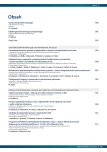The results of liver transplantation in Slovak children
Authors:
J. Kosnáčová 1; J. Hornová 1; Ľ. Podracká 1; P. Gerner 2; S. Kathemann 2
Authors‘ workplace:
I. detská klinika LF UK a DFNsP, Bratislava, Slovenská republika
1; Klinik für Kinder- und Jugendmedizin, Universitätskinderklinik Essen, Nemecko
2
Published in:
Gastroent Hepatol 2015; 69(6): 541-546
Category:
doi:
https://doi.org/10.14735/amgh2015541
Overview
The authors retrospectively summarise the short and long-term results of liver transplantation in Slovak children in the period from January 2002 to August 2015. The surgical procedure itself is performed at transplantation centres abroad, while the pre-/posttransplant management is provided by the 1st Paediatric Department of the Children´s University Hospital and Faculty of Medicine Hospital in Bratislava. The vast majority of children were transplanted in the paediatric centre in Essen, and recently some older patients underwent LTx in Prague. Pre-transplant management comprises a confirmation of the primary disorder, including histology and molecular-genetic testing, special imaging examinations, PEDL score establishment and placement on the waiting list. The post-transplant management focuses on immunosuppression monitoring, on preventing rejection and on the monitoring of long-term infectious and non-infectious complications.
Results:
Thirty-eight liver transplantations in 32 children were performed between January 2002 and August 2015. Biliary atresia was the most common indication. In our centre we are currently monitoring 22 children with liver transplants aged from 9 months to 18 years. One patient aged 19 was referred to a hepatologist for adults, one boy lives with his parents abroad and is in the care of a foreign transplantation centre. The yearly survival rate of the children is 88.4%, eight transplanted children (25%) have died over the 13 years.
Conclusion:
Each year, 2 to 4 new cases of children requiring a liver transplant are registered in Slovakia. Short-term and long-term graft survival is excellent even in the youngest age groups, allowing for the child’s valuable recovery.
Key words:
liver transplantation – living donor – biliary atresia – child – acute liver failure – chronic liver failure
The authors declare they have no potential conflicts of interest concerning drugs, products, or services used in the study.
The Editorial Board declares that the manuscript met the ICMJE „uniform requirements“ for biomedical papers.
Submitted:
9. 11. 2015
Accepted:
19. 11. 2015
Sources
Literatúra
1. National Institutes of Health Consensus Development Conference Statement. Liver Transplantation. Hepatology 1984; 4 (Suppl 1): 107S – 110S.
2.Starzl TE, Busuttil RW, Klintmalm GB. History of liver and other splanchnic organ transplantation. In: Busuttil RW, Klinmalm FG (eds). Transplantation of the Liver 1996. Philadephia, Saunders 1996 : 903.
3. Bismuth H, Houssin D. Reduced-sized orthotopic liver graft in hepatic transplantation in children. Surgery 1984; 95(3): 367 – 370.
4.Kim JS, Broering DC, Tustas RY et al. Split liver transplantation: past, present and future. Pediatr Transplant 2004; 8(6): 644 – 648.
5. Broelsch CE, Whitington PF, Emond JC et al. Liver transplantation. in children from living related donors. Surgical techniques and results. Ann Surg 1991; 214(4): 428 – 439.
6. Martínek V, Matoušovic K, Špatenka J. Objev a užití cyklosporinu v klinické praxi. Prakt Lék 2002; 82 : 14 – 20.
7. Jain A, Reyes J, Kashyap R et al. What have we learned about primary liver transplantation under tacrolimus immunosuppression? Long-term follow-up of the first 1000 patients. Ann Surg 1999; 230(3): 441 – 448.
8. Schukfeh N, Lenz V, Metzelder ML et al.First case studies of successful ABO-incompatible living-related liver transplantation in infants in Germany. Eur J Pediatr Surg 2015; 25(1): 77 – 81. doi: 10.1055/ s-0034-1387936.
9. Eurotransplant. Cooperating within Eurotransplant. [online]. Dostupné z: www.eurotransplant.org/ .
10. Squires RH, Hg V, Romero R et al. Evaluation of the pediatric patient for liver transplantation: 2014 practice guideline by the American Association for the Study of Liver Diseases, American Society of Transplantation and the North American Society for Pediatric Gastroenterology, Hepatology and Nutrition. Hepatology 2014; 60(1): 362 – 398. doi: 10.1002/ hep.27191.
11. Brown RS Jr, Lake JR. The survival impact of liver transplantation in the MELD era, and the future for organ allocation and distribution. Am J of Transplant 2005; 5(2): 203 – 204.
12. Wiesner RH, McDiarmid SV, Kamath PS et al. MELD and PELD: application of survival models to liver allocation. Liver Transpl 2001; 7(7): 567 – 580.
13. Freeman RB Jr, Wiesner RH, Roberts JP et al. Improving liver allocation: MELD and PELD. Am J Transplant 2004; 4 (Suppl 9): 114 – 131.
14. Davenport M, Puricelli V, Farrant P et al. The outcome of the older (> or = 100 days) infant with biliary atresia. J Pediatr Surg 2004; 39(4): 575 – 581.
15. Shneider BL, Brown MB, Haber B et al. A multicenter study of the outcome of biliary atresia in the United States, 1997 to 2000. J Pediatr 2006; 148(4): 467 – 474.
16. Kupčová V, Szántová M, Hrušovský Š et al. Spolupráca slovenských centier pri transplantácii pečene v IKEM. Folia Gastroenterol Hepatol 2005; 3 (Suppl 1): S62 – S68.
Labels
Paediatric gastroenterology Gastroenterology and hepatology SurgeryArticle was published in
Gastroenterology and Hepatology

2015 Issue 6
Most read in this issue
- Ursodeoxycholic acid (Ursosan® capsules)
- Exclusive enteral nutrition – first-line therapy of Crohn’s disease in children
- The results of liver transplantation in Slovak children
- The importance of genetic testing in children with idiopathic chronic pancreatitis
